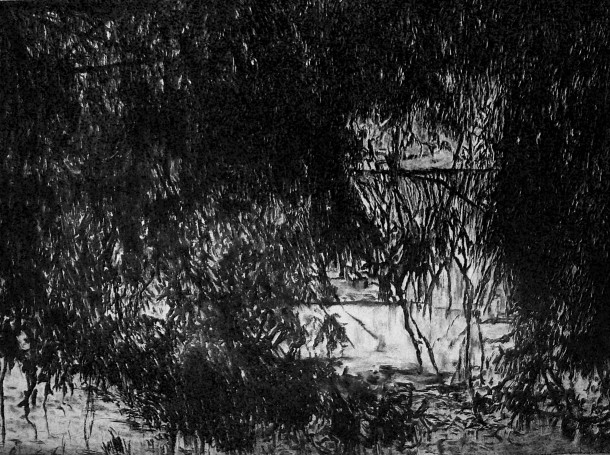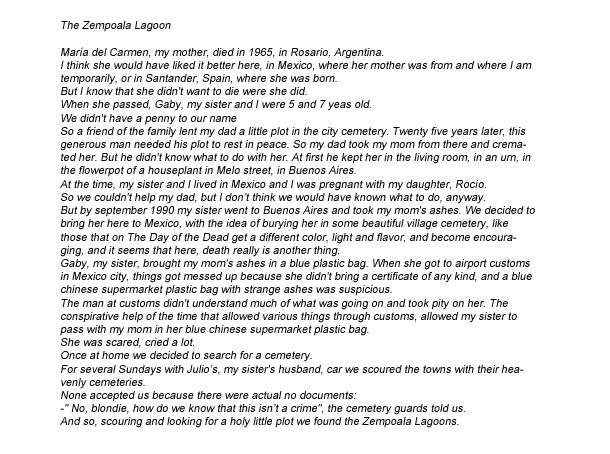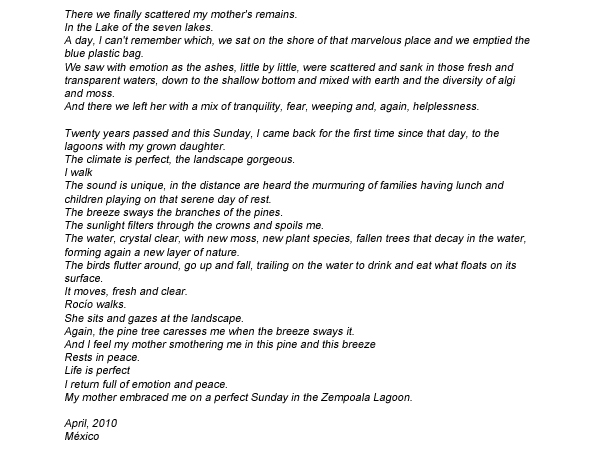Work
Composition study for the Lagunas de Zempoala landscape
Caption
2012
Charcoal on paper and text
154 x 254 cm
Private collection
Artist
By
Text
—
Walk to the water’s source
And await, sitting, for the clouds to lift.
Wang Wei
Like a sentimental project lasting fifteen years thus far, Ana Gallardo’s work has centred on the revaluation and reuse of a personal heritage, hers, and of others who came forward to entrust her with certain fragments. Like Robert Filliou, for whom art was ‘what makes life more interesting than art,’ she perceives artistic creations in everyday life and emotional relationships. Art does not constitute an end in itself; its proposals apply to civil, social and political life.
The need for a narrative, be it text, sonorous or visual, or all three, like exorcism or incantation, is at the centre of her practice. Her works are marked by a very deep spirituality, in that they respect almost religiously emotions, and the objects which shelter them or have sheltered them. By appealing to memory, gathering with sensitivity these relics of intimate stories, love and exile, solitude and absence, the artist revives them, and re-educates as it were the wounded part of the memory.
The Composition study for the Lagunas de Zempoala landscape drawing is part of a project installation consisting of several drawings, a video animation and images which form the narrative of an event in the artist’s life. A text introduces the work, as is often the case in Gallardo’s work, like a cinema or theatre expository scene.
—
The description is simple, factual, lacking in decorum. It evokes the fate of the artist’s mother, deceased over forty years ago, whose body was at first buried for years in the cemetery in the town of Rosario in Argentina, in a grave lent by a family friend, then exhumed to provide room for the friend in question, cremated, placed in an urn in the family apartment, and lastly transported in a small plastic bag to Mexico by Ana’s sister.
The Lagunas de Zempoala National Park is situated in the state of Morelos about fifty kilometres from Mexico City. Ana and her sister Gabi chose this location to scatter their mother’s ashes. The artist returns there with her daughter twenty years later.
The format of the drawing, the density, the boldness of the stroke and the darkness of this landscape which appears bereft, evoke certain basic fears about passing and nothingness, just as much as the completion of a voyage of initiation, the promise of a peaceful otherworldliness. The text illuminates the drawing with clarity and light. Ana Gallardo’s project reasons here with a certain humanism similar to that of Camus: ‘a way of looking at the world without God (the absurd); a way of living there (revolt); a way of behaving there (love).’
Translated from french by Louise Jablonowska
References
François Cheng, Souffle-Esprit, Folio-Essais 545, p. 124
Arnaud Corbic “L’ ‘humanisme athée’ de Camus,” Studies 9/2003 (Volume 399), p. 227-234 - lien.


